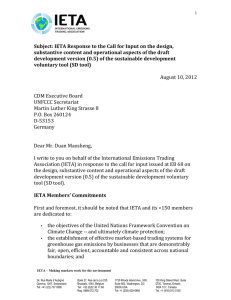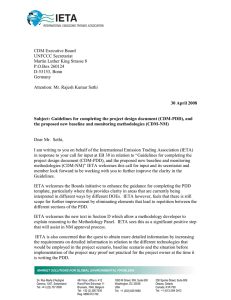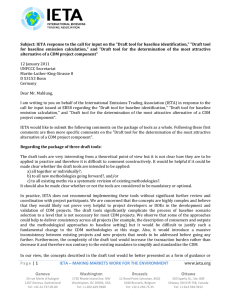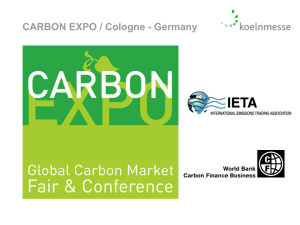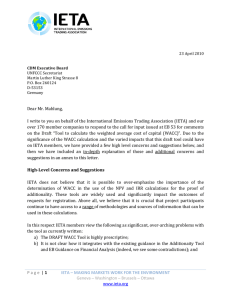Document 11116725
advertisement
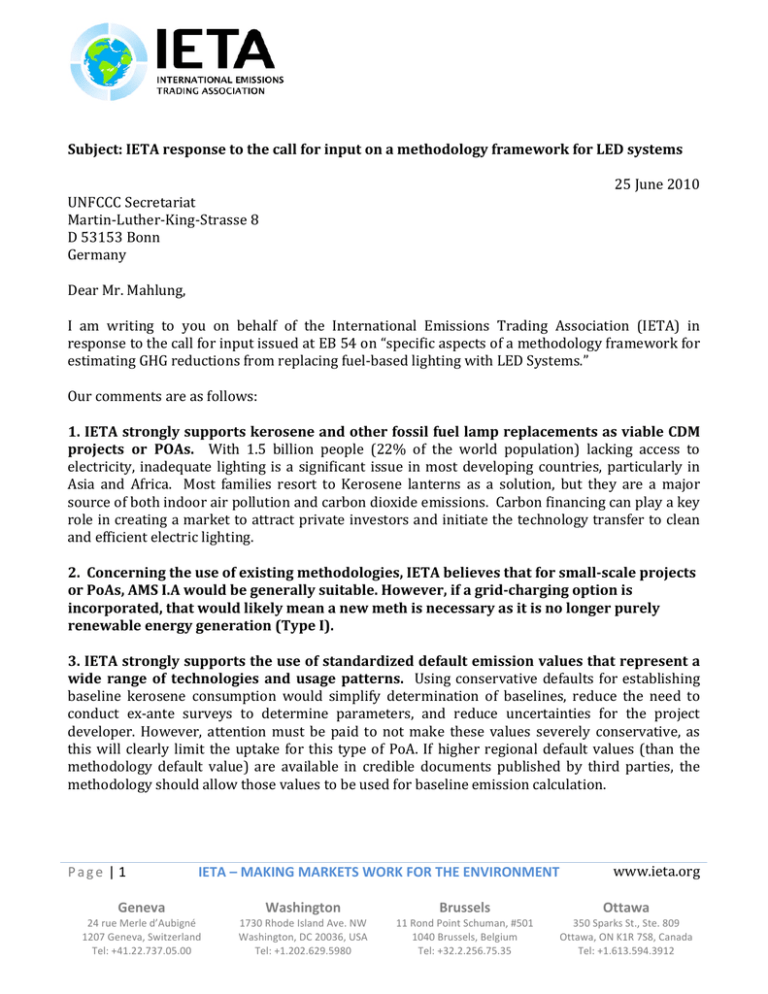
Subject: IETA response to the call for input on a methodology framework for LED systems 25 June 2010 UNFCCC Secretariat Martin-­‐Luther-­‐King-­‐Strasse 8 D 53153 Bonn Germany Dear Mr. Mahlung, I am writing to you on behalf of the International Emissions Trading Association (IETA) in response to the call for input issued at EB 54 on “specific aspects of a methodology framework for estimating GHG reductions from replacing fuel-­‐based lighting with LED Systems.” Our comments are as follows: 1. IETA strongly supports kerosene and other fossil fuel lamp replacements as viable CDM projects or POAs. With 1.5 billion people (22% of the world population) lacking access to electricity, inadequate lighting is a significant issue in most developing countries, particularly in Asia and Africa. Most families resort to Kerosene lanterns as a solution, but they are a major source of both indoor air pollution and carbon dioxide emissions. Carbon financing can play a key role in creating a market to attract private investors and initiate the technology transfer to clean and efficient electric lighting. 2. Concerning the use of existing methodologies, IETA believes that for small-­scale projects or PoAs, AMS I.A would be generally suitable. However, if a grid-­charging option is incorporated, that would likely mean a new meth is necessary as it is no longer purely renewable energy generation (Type I). 3. IETA strongly supports the use of standardized default emission values that represent a wide range of technologies and usage patterns. Using conservative defaults for establishing baseline kerosene consumption would simplify determination of baselines, reduce the need to conduct ex-­‐ante surveys to determine parameters, and reduce uncertainties for the project developer. However, attention must be paid to not make these values severely conservative, as this will clearly limit the uptake for this type of PoA. If higher regional default values (than the methodology default value) are available in credible documents published by third parties, the methodology should allow those values to be used for baseline emission calculation. P a g e | 1 IETA – MAKING MARKETS WORK FOR THE ENVIRONMENT www.ieta.org Geneva 24 rue Merle d’Aubigné 1207 Geneva, Switzerland Tel: +41.22.737.05.00 Washington 1730 Rhode Island Ave. NW Washington, DC 20036, USA Tel: +1.202.629.5980 Brussels 11 Rond Point Schuman, #501 1040 Brussels, Belgium Tel: +32.2.256.75.35 Ottawa 350 Sparks St., Ste. 809 Ottawa, ON K1R 7S8, Canada Tel: +1.613.594.3912 22 March 2010 IETA Input on a Methodology Framework for LED systems An assumed product lifetime of 2-­‐3 years would be acceptable as a conservative default value, but the use of lifetime certificates and monitoring should result in an increase in the crediting period for high quality products. If a simple approach without monitoring is allowed, it should at the same time be possible to improve the conservative default values through voluntary monitoring. Elements from AMS-­‐II.J may be borrowed, especially with regard to sampling. Leaving a scope for using monitoring based on higher alternative values will give projects the opportunity to take seasonal/ geographical variability into account if project developers are willing to invest time and money in carrying out field assessments. Pre-­existing fuel-­based technology 1. IETA agrees with the report that wick-­based kerosene lanterns are the most common baseline technology and can therefore be assumed as conservative default technology. 2. IETA notes that an assumed fuel use rate of 0.025 liters/hour, as suggested in the report, would yield only 0.081 tCO2e per year and per lamp, which is really not much in a 1:1 lamp substitution approach (especially if only a 2 year crediting period is allowed). The assumption of the report (that LED lamps can be completely financed through carbon income) is, in this case, very optimistic from our point of view, taking into account all the costs for setting up the whole project, establishing distribution structures in rural areas of developing countries plus the additional costs for carbon validation, registration and monitoring. Also the uncertainty of the actual carbon credit delivery in the end and the very volatile carbon prices make a business quite risky and not attractive for conventional investors. 3. IETA supports the assumed usage of 3.5 hours per day and 365 days per year suggested in the report for un-­electrified households. However, IETA urges the establishment of alternative usage hours for electrified household, as well as for specific non-­‐household uses (businesses, schools, etc.). There is significant kerosene usage in electrified areas with unreliable grid performance. The report suggests to assume reduced usage patterns of less than 365 days for those areas. While this proposal is reasonable, implementation could be difficult due to a lack of official data depending on the country. IETA suggests that monitoring should be allowed to be used to check and improve the reduced number through ex-­‐post surveys. If the households predominantly use kerosene, then the full number of CERs should be issued. 4. IETA recommends that, as practiced in the report, the given IPCC values for kerosene should be used in determining a fuel emissions factor (kg CO2/liter). 5. As it is difficult to quantify suppressed demand, IETA recommends not including a suppressed demand multiplier, as is suggested in the report, but in turn to also waive the negative multiplier for leakage occurring from persistent use of fuel-­based light sources. P a g e | 2 IETA – MAKING MARKETS WORK FOR THE ENVIRONMENT Geneva – Washington – Brussels – Ottawa www.ieta.org 22 March 2010 IETA Input on a Methodology Framework for LED systems Allowing credits of emission reduction from the suppressed demand would account for the enhanced consumption of kerosene arising due to future developments in provision of energy services due to poverty alleviation and planned initiatives on electrification on electrification of areas by the governments. It also helps push technologies that are cleaner than those in the BAU development path, helping CDM to achieve its sustainable development goals. Regarding changes in lamp usage, IETA believes that the dynamic baseline multiplier as suggested the report is very difficult to quantify. As there can be several positive as well as negative factors which might differ from household to household (e.g. income levels), we suggest to leave this completely out of the calculations. In a conservative technology based 1:1 substitution approach, the influences of such factors are probably negligible. Project Technology 1. IETA regards it as a huge drawback that grid charging lamps cannot currently be included under AMS I.A. (v14). Many LED lights today have the option to be loaded in both ways, via PV and via another electricity source like the grid or a diesel generator. The flexibility is a big advantage for end-­‐users and should not be restricted by a pure renewable energy methodology. 2. IETA supports the findings of the report that destruction of replaced lamps is an unreasonable option for addressing leakage. This is partially because such lamps are easily replaceable low cost technologies and partially because people cannot be forced to quit fuel based lighting altogether, as there may still be a demand for additional light. If the baseline lamp is used in conjunction with the new solar lamp, the additional lighting service provided by both lamps is the suppressed demand and helps take into account the level of consumption needed to pursue an improved standard of living. In such cases, leakage could be neglected. Furthermore, AMs I.A (V14) allows for the assumption that the LED light is new and not necessarily replacing an existing technology (Page 1, Technology/measure: “The renewable generating units may be new installations (Greenfield) or replace existing onsite fossil-­fuel-­fired generation). Under this assumption, no destruction of lamps is necessary. We also agree with the idea that cases where the lighting source is relocated to another household should not be penalized by carbon credit cuts, because actually a positive spillover can be expected if a household which gets electrified is giving away its LED lamp to friends or relatives with lower income where it would still replace kerosene. 3. IETA supports the conservative 1:1 lamp substitution approach suggested in the report, but proposes an option to prove that more than one stand kerosene lamp is substituted for very bright lamps or Solar Home Systems. 4. IETA recommends not including the Net-­to-­Gross factor, as it is unlikely that an LED product in a carbon project will substitute a preexisting LED product rather than a kerosene lantern. This scenario could arise if the previous LED product was not well functioning, but in this case they are relying on kerosene and the baseline would remain the same. P a g e | 3 IETA – MAKING MARKETS WORK FOR THE ENVIRONMENT Geneva – Washington – Brussels – Ottawa www.ieta.org 22 March 2010 IETA Input on a Methodology Framework for LED systems 5. IETA recommends that quality certificates should be earned and rewarded rather than required. Requiring certificates could add significantly to project costs and until now there are no specific off-­‐grid lighting standards available to our knowledge (IETA suggests considering that the IFC and World Bank initiative is mentioned in the report may be a useful, lower cost solution). 6. IETA suggests neglecting the following factors in the calculations: Suppressed demand multiplier and Leakage factor (as these two are anyway weighing each other out to a sum of zero) and Net-­‐to-­‐Gross value (for the reasons provided above). Other issues: 1. Cell phone charging option: We do not recommend generally subtracting 25% of emission reductions if there is a cell phone charging option, as long as the product can prove that a daily 3.5 hour usage for light is still possible over the crediting period. 2. Other baseline fuels besides kerosene: We suggest giving the option to simply subtract the percentage of other fuels used for lighting in a region (e.g. torches, vegetable oil, wood etc.) from the overall emission reductions, because this percentage is usually low and calculating emission reductions of e.g. non-­‐renewable biomass is highly complicated and requires a whole new baseline study about the non-­‐renewability fraction of the biomass in each region. This percentage of baseline fuel other than kerosene would need to be determined at the outset of the PoA, CPA, or both – probably through sampling surveys. IETA greatly appreciates the opportunity to provide our input on this issue in particular and on the development of methodologies in general. Please do not hesitate to contact me at derwent@ieta.org or Kim Carnahan at carnahan@ieta.org should you have any questions regarding this letter. Sincerely, Henry Derwent President and CEO, IETA P a g e | 4 IETA – MAKING MARKETS WORK FOR THE ENVIRONMENT Geneva – Washington – Brussels – Ottawa www.ieta.org
